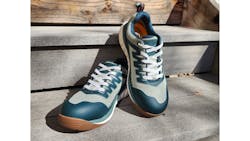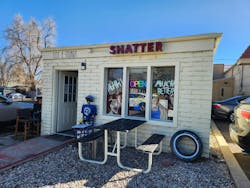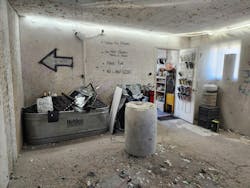Feet of strength: Reviewing the KEEN Utility Arvada Work Sneakers
When it comes to long days in the shop, technicians need to have footwear they can count on—or stand on, in this case. KEEN assembles much of its premium footwear, from work boots to sneakers, in Portland, Oregon. The Arvada Work Sneakers offer the best of both, featuring the cushion of an athletic shoe and—because of the carbon-fiber safety toe—the protection of a work boot. It's exactly what a shop technician would need to get through long shifts. It doesn't hurt that the teal- and turquoise-hued shoes are pretty stylish, too. KEEN sent me a pair of the women's version to test out and share my impressions.
The work sneakers
More lightweight than steel, the asymmetrical carbon-fiber toes of the Arvada work sneaker are 100% non-metallic and offer an unobtrusive fit for maximum comfort and protection. The outsoles are also oil- and slip-resistant, perfect for any spills during oil changes, and electric-hazard-rated against live circuits for technicians working on electrical systems.
Additionally, the insole is “compression-resisting” and offers 50% more energy return than typical EVA foam, KEEN claims, while the outer design features plastic, nylon, or concealed eyelets to protect vehicles from accidental contact. Finally, the shoe offers abrasion-resistant, high-tensile, tear-resistant fabric across the top and sides of the foot for greater protection.
The women's version of the shoes come in sizes 5-11 and in gray, teal, or black. Meanwhile, the men's sneakers come in sizes 7-15 and include taupe, blue dark gray, and black for color options.
To the test
So how do these shoes perform in real-life situations? I’m no technician, but I figured a bit of testing at my local Rage Room would let me put the Arvada work sneakers through their paces.
Before seeing how they held up in a session of smashing objects and relieving stress, I broke the sneakers in for a few days. They were comfortable in the heels when I worked at my luxurious standing desk (also known as the kitchen island) and provided good arch support when I took them out for a hike in the foothills. Then, it was time to put on the pressure.
My testing location of choice was the Shatter Rage Room located in Fort Collins, Colorado.
On the menu for destruction were two plates, five glasses, two computer mice, one computer monitor, and a bin of discarded furniture and metal appliances. I had 15 minutes to pulverize what I could, hoping these Arvada sneakers would keep my toes from being crushed in the process. Even before raging against the obsolete machines, I was grateful for the Arvadas' level of exterior durability, as the 'destruction room' floor was covered in shards of broken glass and left-behind crockery, particularly by the western wall where all of the smashings occurred. But with the sneakers' thick outsoles, I moved freely and did not have to worry about picking glass out of my shoes later.
The carbon-fiber toes provided apt protection as well, as kicking our assortment of glassware and the computer monitor did no damage to me, not even when I missed and kicked the heavy wooden stump I was using to pose my objects instead. I was similarly unscathed moving across broken component pieces of a computer keyboard, a microwave, and another monitor from the miscellaneous bin on the north side of the room. The abrasion-resistant fabric also protected my foot when I got tangled in an old circuit board and pieces of a lawn chair during clean-up.
Overall, no debris, splinters, or shavings breached the Arvada sneakers' defenses. The tread's grip was good even on the pitted cement floor, and despite my best efforts, the shoes came away with barely a scuff. They were comfortable to wear in all circumstances and only came off my foot once (but I'm willing to admit that's more due to my lacing skills, not the shoes).
One thing to keep in mind is that while the sneakers were lighter than a traditional work boot, they also provided less ankle support. I can imagine in heavy-duty applications, a technician would prefer a boot to brace their ankles more. But overall, the Arvada sneakers were very comfortable and offered plenty of protection and grip for a long day in the shop doing light work. At the very least, consider them rage room approved.
About the Author

Alex Keenan
Alex Keenan is an Associate Editor for Fleet Maintenance magazine. She has written on a variety of topics for the past several years and recently joined the transportation industry, reviewing content covering technician challenges and breaking industry news. She holds a bachelor's degree in English from Colorado State University in Fort Collins, Colorado.


